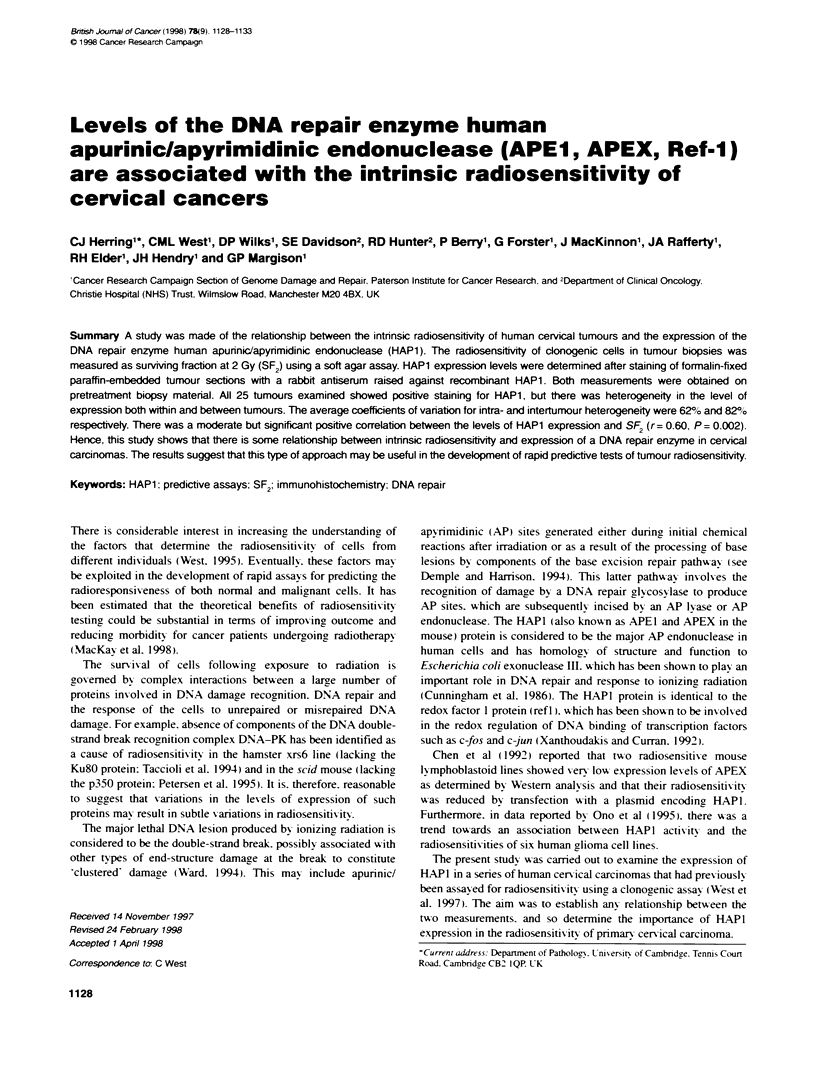Levels of the DNA repair enzyme human apurinic/apyrimidinic endonuclease (APE1, APEX, Ref-1) are associated with the intrinsic radiosensitivity of cervical cancers (original) (raw)
Abstract
A study was made of the relationship between the intrinsic radiosensitivity of human cervical tumours and the expression of the DNA repair enzyme human apurinic/apyrimidinic endonuclease (HAP1). The radiosensitivity of clonogenic cells in tumour biopsies was measured as surviving fraction at 2 Gy (SF2) using a soft agar assay. HAP1 expression levels were determined after staining of formalin-fixed paraffin-embedded tumour sections with a rabbit antiserum raised against recombinant HAP1. Both measurements were obtained on pretreatment biopsy material. All 25 tumours examined showed positive staining for HAP1, but there was heterogeneity in the level of expression both within and between tumours. The average coefficients of variation for intra- and intertumour heterogeneity were 62% and 82% respectively. There was a moderate but significant positive correlation between the levels of HAP1 expression and SF2 (r = 0.60, P = 0.002). Hence, this study shows that there is some relationship between intrinsic radiosensitivity and expression of a DNA repair enzyme in cervical carcinomas. The results suggest that this type of approach may be useful in the development of rapid predictive tests of tumour radiosensitivity.

Images in this article
Selected References
These references are in PubMed. This may not be the complete list of references from this article.
- Chen D. S., Herman T., Demple B. Two distinct human DNA diesterases that hydrolyze 3'-blocking deoxyribose fragments from oxidized DNA. Nucleic Acids Res. 1991 Nov 11;19(21):5907–5914. doi: 10.1093/nar/19.21.5907. [DOI] [PMC free article] [PubMed] [Google Scholar]
- Cunningham R. P., Saporito S. M., Spitzer S. G., Weiss B. Endonuclease IV (nfo) mutant of Escherichia coli. J Bacteriol. 1986 Dec;168(3):1120–1127. doi: 10.1128/jb.168.3.1120-1127.1986. [DOI] [PMC free article] [PubMed] [Google Scholar]
- Dahm-Daphi J., Dikomey E. Rejoining of DNA double-strand breaks in X-irradiated CHO cells studied by constant- and graded-field gel electrophoresis. Int J Radiat Biol. 1996 May;69(5):615–621. doi: 10.1080/095530096145625. [DOI] [PubMed] [Google Scholar]
- Demple B., Harrison L. Repair of oxidative damage to DNA: enzymology and biology. Annu Rev Biochem. 1994;63:915–948. doi: 10.1146/annurev.bi.63.070194.004411. [DOI] [PubMed] [Google Scholar]
- Duguid J. R., Eble J. N., Wilson T. M., Kelley M. R. Differential cellular and subcellular expression of the human multifunctional apurinic/apyrimidinic endonuclease (APE/ref-1) DNA repair enzyme. Cancer Res. 1995 Dec 15;55(24):6097–6102. [PubMed] [Google Scholar]
- Jayaraman L., Murthy K. G., Zhu C., Curran T., Xanthoudakis S., Prives C. Identification of redox/repair protein Ref-1 as a potent activator of p53. Genes Dev. 1997 Mar 1;11(5):558–570. doi: 10.1101/gad.11.5.558. [DOI] [PubMed] [Google Scholar]
- La Belle M., Linn S. DNA repair in cultured mouse cells of increasing population doubling level. Mutat Res. 1984 Jul-Aug;132(1-2):51–61. doi: 10.1016/0167-8817(84)90066-x. [DOI] [PubMed] [Google Scholar]
- MacKay R. I., Niemierko A., Goitein M., Hendry J. H. Potential clinical impact of normal-tissue intrinsic radiosensitivity testing. Radiother Oncol. 1998 Feb;46(2):215–216. doi: 10.1016/s0167-8140(97)00179-5. [DOI] [PubMed] [Google Scholar]
- Ono Y., Matsumoto K., Furuta T., Ohmoto T., Akiyama K., Seki S. Relationship between expression of a major apurinic/apyrimidinic endonuclease (APEX nuclease) and susceptibility to genotoxic agents in human glioma cell lines. J Neurooncol. 1995;25(3):183–192. doi: 10.1007/BF01053151. [DOI] [PubMed] [Google Scholar]
- Peterson S. R., Kurimasa A., Oshimura M., Dynan W. S., Bradbury E. M., Chen D. J. Loss of the catalytic subunit of the DNA-dependent protein kinase in DNA double-strand-break-repair mutant mammalian cells. Proc Natl Acad Sci U S A. 1995 Apr 11;92(8):3171–3174. doi: 10.1073/pnas.92.8.3171. [DOI] [PMC free article] [PubMed] [Google Scholar]
- Taccioli G. E., Gottlieb T. M., Blunt T., Priestley A., Demengeot J., Mizuta R., Lehmann A. R., Alt F. W., Jackson S. P., Jeggo P. A. Ku80: product of the XRCC5 gene and its role in DNA repair and V(D)J recombination. Science. 1994 Sep 2;265(5177):1442–1445. doi: 10.1126/science.8073286. [DOI] [PubMed] [Google Scholar]
- Thacker J., Wilkinson R. E. The genetic basis of resistance to ionising radiation damage in cultured mammalian cells. Mutat Res. 1991 Mar;254(2):135–142. doi: 10.1016/0921-8777(91)90004-9. [DOI] [PubMed] [Google Scholar]
- Walker L. J., Craig R. B., Harris A. L., Hickson I. D. A role for the human DNA repair enzyme HAP1 in cellular protection against DNA damaging agents and hypoxic stress. Nucleic Acids Res. 1994 Nov 25;22(23):4884–4889. doi: 10.1093/nar/22.23.4884. [DOI] [PMC free article] [PubMed] [Google Scholar]
- Ward J. F. The complexity of DNA damage: relevance to biological consequences. Int J Radiat Biol. 1994 Nov;66(5):427–432. doi: 10.1080/09553009414551401. [DOI] [PubMed] [Google Scholar]
- West C. M., Davidson S. E., Roberts S. A., Hunter R. D. The independence of intrinsic radiosensitivity as a prognostic factor for patient response to radiotherapy of carcinoma of the cervix. Br J Cancer. 1997;76(9):1184–1190. doi: 10.1038/bjc.1997.531. [DOI] [PMC free article] [PubMed] [Google Scholar]
- West C. M. Invited review: intrinsic radiosensitivity as a predictor of patient response to radiotherapy. Br J Radiol. 1995 Aug;68(812):827–837. doi: 10.1259/0007-1285-68-812-827. [DOI] [PubMed] [Google Scholar]
- Wurm R., Burnet N. G., Duggal N., Yarnold J. R., Peacock J. H. Cellular radiosensitivity and DNA damage in primary human fibroblasts. Int J Radiat Oncol Biol Phys. 1994 Oct 15;30(3):625–633. doi: 10.1016/0360-3016(92)90949-i. [DOI] [PubMed] [Google Scholar]
- Xanthoudakis S., Curran T. Identification and characterization of Ref-1, a nuclear protein that facilitates AP-1 DNA-binding activity. EMBO J. 1992 Feb;11(2):653–665. doi: 10.1002/j.1460-2075.1992.tb05097.x. [DOI] [PMC free article] [PubMed] [Google Scholar]